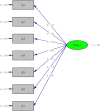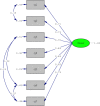Psychometric Evaluation of the Arabic Version of the Fear of COVID-19 Scale
- PMID: 32427217
- PMCID: PMC7229877
- DOI: 10.1007/s11469-020-00316-x
Psychometric Evaluation of the Arabic Version of the Fear of COVID-19 Scale
Abstract
Fear is a central emotional response to imminent threats such as the coronavirus-19 disease (COVID-19). The Fear of COVID-19 Scale (FCV-19S) assesses the severity of fear towards COVID-19. The present study examined the psychometric properties of the Arabic version of the FCV-19S. Using a forward-backward translation, the FCV-19S was translated into Arabic. An online survey using the Arabic versions of FCV-19S and the Hospital Anxiety and Depression Scale (HADS) was administered. Reliability and concurrent and confirmatory validity were examined. The dataset consisted of 693 Saudi participants. The internal consistency of the Arabic FCV-19S was satisfactory (α = .88), with sound concurrent validity indicated by significant and positive correlations with HADS (r = .66). The unidimensional structure of the FCV-19S was confirmed. The Arabic version of the FCV-19S is psychometrically robust and can be used in research assessing the psychological impact of COVID-19 among a Saudi adult population.
Keywords: Arabic FCV-19S; COVID-19; Coronavirus; Fear of COVID-19 Scale; Saudi Arabia.
© Springer Science+Business Media, LLC, part of Springer Nature 2020.
Conflict of interest statement
Conflict of InterestThe authors declare that they have no conflict of interest.
Figures
References
-
- Alyami, M., Al-Sharef, A., Al-Aseri, M., & Henning, M. (2019). Mammography self-efficacy scale and breast cancer fear scale: psychometric properties of the Arabic versions among Saudi women. Cancer Nursing. 10.1097/NCC.0000000000000767. - PubMed
-
- Bukhari EE, Temsah MH, Aleyadhy AA, Alrabiaa AA, Alhboob AA, Jamal AA, Binsaeed AA. Middle East respiratory syndrome coronavirus (MERS-CoV) outbreak perceptions of risk and stress evaluation in nurses. Journal of Infection in Developing Countries. 2016;10(8):845–850. doi: 10.3855/jidc.6925. - DOI - PubMed
LinkOut - more resources
Full Text Sources
Medical


